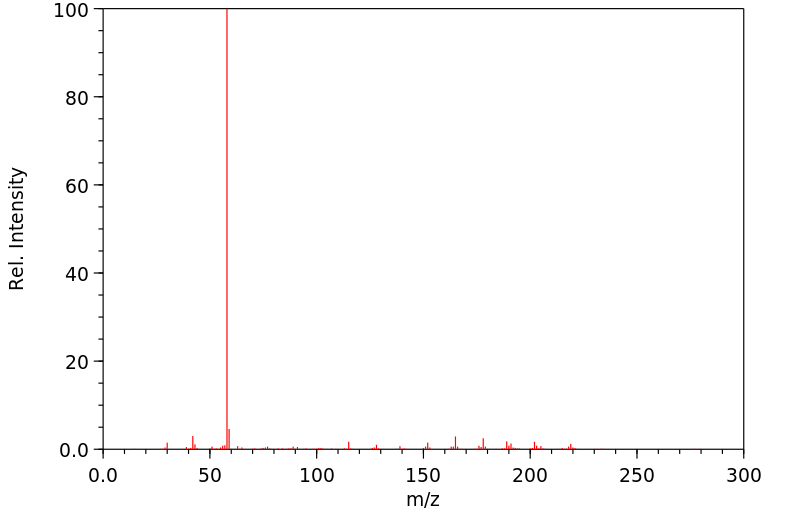(3Z)-3-(二苯并[b,e]氧杂卓-11(6H)-亚基)-N,N-二甲基-1-丙胺 | 3607-18-9
-
物化性质
-
计算性质
-
ADMET
-
安全信息
-
SDS
-
制备方法与用途
-
上下游信息
-
文献信息
-
表征谱图
-
同类化合物
-
相关功能分类
-
相关结构分类
物化性质
-
熔点:192-193°
-
颜色/状态:OILY LIQUID CONSISTING OF A MIXTURE OF CIS- & TRANS- ISOMERS
-
气味:ODORLESS
-
味道:BITTER
-
沸点:154-157 ºC at 0.03 mmHg
-
溶解度:31.6 mg/L (at 25 °C)
-
稳定性/保质期:
DECOMP SLOWLY IN LIGHT, NONHYGROSCOPIC UP TO 75% RELATIVE HUMIDITY, RELATIVELY STABLE IN HEAT /HYDROCHLORIDE/
-
分解:When heated to decomposition it emits toxic fumes of nitroxides.
-
保留指数:2231;2210;2210;2194;2210;2239;2226;2215;2217;2191.6;2219.1;2219.8;2242;2220;2235;2217;2232.1
计算性质
-
辛醇/水分配系数(LogP):4.3
-
重原子数:21
-
可旋转键数:3
-
环数:3.0
-
sp3杂化的碳原子比例:0.26
-
拓扑面积:12.5
-
氢给体数:0
-
氢受体数:2
ADMET
SDS
上下游信息
-
上游原料
中文名称 英文名称 CAS号 化学式 分子量 6,11-二氢二苯并[b,e]氧杂卓-11-酮 6,11-dihydrodibenz[b,e]oxepin-11-one 4504-87-4 C14H10O2 210.232 -
下游产品
中文名称 英文名称 CAS号 化学式 分子量 —— (E)-doxepin 3607-34-9 C19H21NO 279.382 (Z)-去甲基多塞平 (Z)-Desmethyldoxepin 58534-46-6 C18H19NO 265.355 —— (Z)-doxepine-N-oxide 131523-92-7 C19H21NO2 295.381
反应信息
-
作为反应物:描述:参考文献:名称:Methods of using low-dose doxepin for the improvement of sleep摘要:通过使用低剂量多塞平(例如1-6毫克),可以预防早醒,并提高睡眠效率,使睡眠周期中第7和第8小时的睡眠更好。公开号:US20070281990A1
-
作为产物:描述:参考文献:名称:Methods of using low-dose doxepin for the improvement of sleep摘要:通过使用低剂量多塞平(例如1-6毫克),可以预防早醒,并提高睡眠效率,使睡眠周期中第7和第8小时的睡眠更好。公开号:US20070281990A1
文献信息
-
Iron(II) promoted direct synthesis of dibenzo[b,e]oxepin-11(6H)-one derivatives with biological activity. A short synthesis of doxepin作者:Jimena Scoccia、M. Julia Castro、M. Belén Faraoni、Cecilia Bouzat、Víctor S. Martín、Darío C. GerbinoDOI:10.1016/j.tet.2017.03.085日期:2017.5excellent yields and high regioselectivity. The synthetic application of new protocol was extended to the synthesis of known tricyclic drug doxepin as well as a small library of oxepin based derivatives. For the first time, the obtained dibenzo[b,e]oxepinone derivatives were evaluated for their biological activities on the free-living nematode Caenorhabditis elegans as an effective and cost-efficient model
-
The photochemical stability of <i>cis-</i> and <i>trans</i>- isomers of tricyclic neuroleptic drugs作者:A Li wan Po、W J IrwinDOI:10.1111/j.2042-7158.1980.tb12839.x日期:2011.4.12
Abstract The irradiation of the tranquillizers flupenthixol, clopenthixol and chlorprothixene has been found to induce rapid cis-trans isomerization. The composition of the photostationary mixture is not that of the batch drug and hence this process may affect the activity. Further decomposition to a thioxanthone derivative occurs rapidly in the presence of air. Exclusion of oxygen, however, does not prevent further degradation and a slower secondary isomerization is observed on prolonged irradiation. Doxepin and dothiepin also undergo analogous reactions but the isomerizations are much slower and the oxidative degradation yields many products.
-
COMPOSITIONS AND METHODS FOR THE TREATMENT OF MUCOSITIS申请人:CELLIX BIO PRIVATE LIMITED公开号:US20170327482A1公开(公告)日:2017-11-16The invention relates to the compounds of formula I, formula II, formula III, formula IV, formula V, formula VI, formula VII and formula VIII, or its pharmaceutical acceptable polymorphs, solvates, enantiomers, stereoisomers and hydrates thereof. The pharmaceutical compositions comprising an effective amount of compounds of formula I, formula II, formula III, formula IV, formula V, formula VI, formula VII and formula VIII, and methods for the treatment of mucositis may be formulated for oral, mouth wash, buccal, rectal, topical, transdermal, transmucosal, intravenous, oral solution, buccal mucosal layer tablet, parenteral administration, syrup, or injection. Such compositions may be used to treatment of oral and gastrointestinal mucositis, mucosal inflammatory and oral infectious diseases.本发明涉及式I、式II、式III、式IV、式V、式VI、式VII和式VIII的化合物,或其药学上可接受的多晶形、溶剂化物、对映体、立体异构体和水合物。该药物组合物包括有效量的式I、式II、式III、式IV、式V、式VI、式VII和式VIII化合物,以及用于口服、漱口、颊部、直肠、局部、经皮、经黏膜、静脉、口服溶液、颊粘膜层片剂、肌肉注射、糖浆或注射制剂的治疗口腔炎症的方法。这些组合物可用于治疗口腔和胃肠黏膜炎症和口腔感染性疾病。
-
Pharmaceutical preparation comprising an active dispersed on a matrix申请人:——公开号:US20040058896A1公开(公告)日:2004-03-25The present invention relates to the field of pharmaceutical technology and describes a novel advantageous preparation for an active ingredient. The novel preparation is suitable for producing a large number of pharmaceutical dosage forms. In the new preparation an active ingredient is present essentially uniformly dispersed in an excipient matrix composed of one or more excipients selected from the group of fatty alcohol, triglyceride, partial glyceride and fatty acid ester.
-
一种以邻苯二甲醛为原料合成盐酸多塞平的方法
表征谱图
-
氢谱1HNMR
-
质谱MS
-
碳谱13CNMR
-
红外IR
-
拉曼Raman
-
峰位数据
-
峰位匹配
-
表征信息







